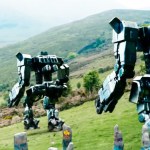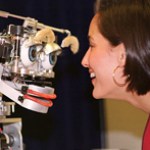robots
I have a love-hate relationship with farmers. I have a great deal of respect for the enterprise and for those who dedicate their lives to it. But, I also become annoyed at the culture in which modern American farming embeds itself. And, I don't feel a lot of reticence talking openly about that.
Having done plenty of farming myself, I don't feel the need that so many others do to be extra nice to farmers out of lack of understanding. I know when the farmers complain about too little or too much rain, they are studiously ignoring the fact that if it is harder to plant or harvest, they make out…
Tenergy is a company that you know well even if you don't know them. They make a lot of the replacement batteries for everything, external power supplies, other electronic items. But recently they've added a few items to their line of products that reach out in an entirely different direction.
Tenergy Odev Tomo 2-in-1 Transformable DIY STEM Education Programmable Robot Kit is a robot kit that can be configured as a tricycle with two large wheels, or as a two-wheeled "bicycle" which operates like a Segway. Which is pretty amazing.
So far Tomo is my favorite out of the box Robot Build, and I…
Scratch Programming Playground: Learn to Program by Making Cool Games is a brand new offering from No Starch Press.
Never mind all the other programming books for kids, this is the best so far.
It helps that the Scratch Programming environment is so easy to use and allows such creative development, and it also helps that Scratch is likely to be a programming environment for basic robotics in the future (as I discuss briefly here). But the book itself is excellent, and works at several levels. A young kid working with an adult, a medium level kid working on their own, or an adult playing…
No, not that one. This one:
SpotMini is a new smaller version of the Spot robot, weighing 55 lbs dripping wet (65 lbs if you include its arm.) SpotMini is all-electric (no hydraulics) and runs for about 90 minutes on a charge, depending on what it is doing. SpotMini is one of the quietest robots we have ever built. It has a variety of sensors, including depth cameras, a solid state gyro (IMU) and proprioception sensors in the limbs. These sensors help with navigation and mobile manipulation. SpotMini performs some tasks autonomously, but often uses a human for high-level guidance. For more…
Reading a term paper by one of my Växjö students, I learned something surprising.
Being a well-read and erudite sort, Dear Reader, you may not be surprised. You already know that Japanese women have been having very few babies each since the 1950s, and that thus there's a growing shortage of strong young people to work in the care for the elderly. It has gone so far, and the prognosis is so dire, that the Japanese electronics industry is busy developing robots to care for old folks.
What I learned is that the problem is really one of xenophobia. All of Japan's neighbouring countries across…
I felt a sense of déjà vu Tuesday morning when I heard NPR's Nell Greenfieldboyce reporting on Senator Tom Coburn's attacks on National Science Foundation-funded research. I realized that the same thing happened last August, and I wrote about it in a post called "Scoring Political Points by Misunderstanding Science." Last year, the report mocked research into addiction and older adults' cognition (among many other projects) because the projects involved administering cocaine to monkeys and introducing senior citizens to Wii games. This year, the projects up for ridicule include…
By Dr. Cynthia Phillips
Planetary geologist at the Carl Sagan Center for the Study of Life in the Universe, SETI Institute
The final mission of Space Shuttle Atlantis has spawned a whole series of perspective pieces on the history, state, and future of space exploration. Some, like the YouTube video "NASA's increase of awesome to continue," are unabashedly exuberant celebrations of the future in store for us in space; others, like this thoughtful piece in Technology Review entitled "Was the Space Shuttle a Mistake?," are depressingly and effectively critical of the cost both in dollars (more…
What games would a robot play? It's a question that struck me last night, and kept me up as I sketched out diagrams for android puzzle toys.
For a start, we have to imagine why a robot would play games. We're not even able to explain why we enjoy them so much. To say that games trigger the reward system in the brain doesn't add anything by way of an explanation. Enjoyment, pleasure, is an atomic building block of behaviour, it's impossible to break it down any further. So why ask why robots would play games when we can't explain our own fascination with them? They just do. We can give…
Meet Nifty Fifty Speaker Catherine Mohr, Nominated by FIRST.
She began her career as a mechanical engineer, working many years developing alternative-energy vehicles and high-altitude aircraft. But a mid-career change set Catherine Mohr on a different path for which she is known today: developing the next generation of surgical robots and robotic procedures that allow patients to heal faster and better.
If the idea of a robot helping to perform surgery makes you nervous -relax. Thousands of robotically assisted surgeries are performed every year in the U.S, operations which allow human…
Hod Lipson is noted for bringing biologically-inspired approaches to the study of robotics - all in an effort to answer what he believes to be two great challenging questions in engineering: "First, can we design machines that can design other machines, and second, can we make machines that can make other machines?" he asks.
Both of these questions, Hod contends, lie at the crux of understanding the engineering process itself, and science's ability to design, make and maintain complex machines, like robots, in the future.
Biological life itself, he says, has answered many of these questions…
She has developed some of the world's most famous robots - humanoid
creatures like "Kismet" (a robotic head that has been widely featured in
international media) and "Nexi," a mobile dexterous social robot that learns from
and interacts with people in an intelligent, life-like and sociable manner.
But Cynthia Breazeal, associate professor of Media Arts and Sciences at the
Massachusetts Institute of Technology where she founded and directs the
Personal Robots Group at the Media Lab, says she has much more ground to
cover in the growing field of social robotics.
"My research explores…
Detroit Industry by Diego Rivera
To put this post in larger context, Paul Krugman stirred up quite a ruckus with a column that argued that a lot of jobs for college graduates are being rendered obsolete by technological change. For scientists, this is not a new phenomenon. At a recent celebration type-of-thing, a colleague explained how a Prominent Genomic Researcher realized that the next leap forward in biology was going to happen when biologists would view their science as an information science. The future was not going to involve benches filled with dozens of Ph.D.s furiously…
Check out the cool Robots at the Expo!
The WildStang Robotics Team, housed at Rolling Meadows High School and comprised of students from Rolling Meadows, Wheeling, Prospect, and Elk Grove High Schools is travelling to Washington, D.C. October 21-25 to participate in the first ever USA Science and Engineering Festival being held on the National Mall.
Twenty-three students are travelling to Washington. Chaperones and several engineering mentors from corporate sponsor Motorola will also attend the event. The WildStang Robotics Team will demonstrate several different robots representing FIRST.…
The innovative new opera by Tod Machover, Death and the Powers, opens this Friday for its world premiere in Monte Carlo at Opéra Garnier de Monte-Carlo. Machover gave Festival-goers a sneak peak of this hugely ambitious work earlier this summer at the 2010 World Science Festival, which included a thought-provoking conversation with AI legend Marvin Minsky.
The opera—a brainchild of Machover's Opera of the Future Group at the MIT Media Lab in co-production with American Repertory Theatre—explores transhumanist and existential territory, such as mortality and theory of mind, as well as…
There's a lot of fascinating robotics work being done these days, although it is disheartening to see how much of it is designed to help kill people or just kill them outright. But not all of it and over at Boingboing there was an example of a project designed to do household chores. We already have Roombas to clean the floor and a lot of laundry is sort of automated (at least the wash, scrub, rinse, dry cycles are). But then there's the unpleasant task of taking them out of the washing machine, dumping them into the drier, taking them out of the drier and folding them. The firs three of…
In a Swiss laboratory, a group of ten robots is competing for food. Prowling around a small arena, the machines are part of an innovative study looking at the evolution of communication, from engineers Sara Mitri and Dario Floreano and evolutionary biologist Laurent Keller.
They programmed robots with the task of finding a "food source" indicated by a light-coloured ring at one end of the arena, which they could "see" at close range with downward-facing sensors. The other end of the arena, labelled with a darker ring was "poisoned". The bots get points based on how much time they spend near…
Because everyone else is finding out what their cyborg name is:
Get Your Cyborg Name
I like it!
Or maybe not. By way of ScienceBlogling Ed Yong, I came across tweenbots, which are little robots that can only travel in one direction, and...well, just watch the video:
So I wanted to see what else tweenbot inventor Kacie Kinzer came up with. While I like the Morgen, it is the Whisper Jar that strikes me as particularly neato:
Whisper jars are magical containers for secrets. Whisper something into the jar, close the lid, and your secret will be contained until someone else comes along and opens the jar. When they do, the secret escapes-- is repeated once for one person to hear-- and then…
"You couldn't make this up: Cameras are being turned on the people paid to watch CCTV streams, to note which bits of surveillance footage they didn't see." via BoingBoing
The beauty of sand, close up -- a photo gallery at Discover.
Robots as recruitment to science. "If you stick a robot--I don't care if you're talking about grade school kids or high school students--if you put a robot in the middle of the room, there is something captivating about the technology." from Making Robots Personal - an interview with Tandy Trower of Microsoft Robotics. I find this particularly relevant as my 7-y.…
While the robotic title character in WALL-E inhabited an Earth of the future, robots are here now, in our labs, factories, and even art galleries. At Aberystwyth University in Wales, a robot named Adam is designing and carrying out genetic tests on yeast, modifying the experiments on its own as it records and processes data. At the Allen Institute for Brain Science in Seattle, robots methodically analyze frozen slices of the brain to create a genetic map of the entire organ. And in art galleries across Europe and North America, artist Wim Delvoye's "Cloaca" machines mimic natural human waste…








